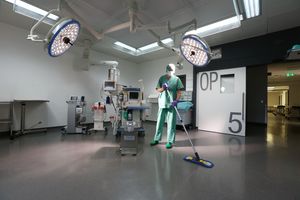KANBrief 2/20

The current spread of the SARS-CoV-2 coronavirus underscores the importance of good hygiene for the prevention of infections. In hospitals in particular, cleaning has an important function in reducing the number of microorganisms on surfaces and thus lowering the risk of infection for patients, workers and visitors. The new DIN 13063 standard governing hospital cleaning is intended to set uniform standards for the cleaning process.
Even before the current pandemic, cleanliness in hospitals was a regular topic of discussion, particularly with regard to multi-resistant bacteria. Workers, patients and visitors must be protected against infections. For patients with underlying conditions or immunocompromised persons, in particular, regular and efficient cleaning and disinfection can be vital.
When performed properly, cleaning also protects nursing and medical staff against smear infection, and is therefore an important part of occupational safety and health in hospitals. At the same time, it must be ensured that the cleaning personnel themselves are also protected against pathogenic microorganisms and chemical hazards caused by cleaning agents. Corresponding requirements for the protection of workers are set out in various national rules and regulations in Germany. Examples are the Ordinances on biological substances (BioStoffV) and hazardous substances (GefstoffV), and technical rules (TRBA 250, TRGS 525).
The draft DIN 13063 standard, Hospital cleaning – Requirements for cleaning or disinfection cleaning in hospitals and other health care facilities, was published in March 2020. The standard is intended for all decision-makers and parties involved in cleaning services in hospitals.
The draft standard defines the quality of the structure, process and results for the cleaning and disinfection of surfaces. It sets out requirements to be met by the customers and service providers. These requirements include, for example, specification of the service, information channels/communication, responsibilities and competencies, quality management, material requirements and hygiene requirements. Requirements concerning the expertise to be possessed by the personnel (cleaners and persons tasked with ensuring hygiene) and test methods for monitoring of the cleaning process are also described.
Standards for services frequently set out requirements not only for performance of the service itself, but also for the qualifications of the personnel, requirements concerning the building structure, room equipment, and the safety and health of workers at work. Under EU law (pdf), the safety and health of workers at work falls within the regulatory scope of the Member States. In order for duplication of provisions or for that matter contradiction between them to be avoided, issues concerning the safety and health of workers at work should as a matter of principle not be the subject of standardization (CEN Guide 15, Guidance document for the development of service standards).
Service standards in the healthcare sector are a good example of where it may be difficult to separate the safety and health of workers at work (protection of cleaning personnel themselves) clearly from the protection of patients. This is the case for example when personal protective equipment is used. Requirements for qualifications can also serve both objectives, i.e. they may enhance the quality of the service, besides having the purpose of protecting the workers.
The KAN Secretariat monitored development of the draft standard. The safety and health of workers at work was excluded from the draft standard’s scope. In the document itself, reference is made at various points to the relevant state rules and regulations and those of the accident insurance institutions. For example, the current draft does not describe the technical and structural design of laundries, referring instead to the relevant rule and informative document published by the DGUV. For provision of the necessary changing rooms, staff rooms, break rooms and washing facilities, reference is made to the German Ordinance on workplaces (ArbstättV).
Since the SARS-CoV-2 pandemic has resulted in a high workload for many of the experts involved, the public enquiry phase for the draft standard has been extended. The draft of DIN 13063 is available to all interested experts, who may submit comments through the DIN draft standards portal until 6 August.
Dr. Anna Dammann